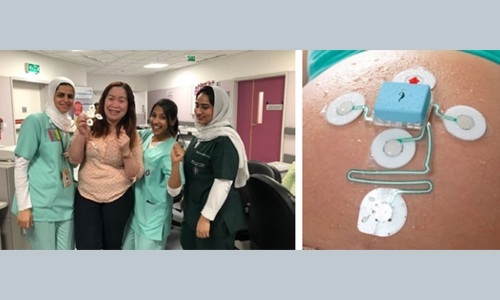King Hamad University Hospital changing labour experience
When it comes to labour and delivery, comfort and safety are critical to ensure a positive patient experience. However, ‘labour’ and ‘comfort’ are rarely used in the same sentence. Until now, moms-to-be had to be strapped to transducers, belts and cables to accurately monitor both the baby and mom. This restricted the patient’s movement, caused discomfort, and required the nurse to constantly readjust the transducers, belts and cables with even the slightest movement.
Fortunately, a new wireless monitor is changing the labour experience. Now, for the first time in the Middle East, King Hamad University Hospital (KHUH) in Bahrain offers the Novii Wireless Patch System, which monitors fetal heart rate, maternal heart rate and uterine activity, all with a single wireless patch.
Patients can have the freedom to choose their labouring position and get up, walk around— even bathe*—all while providing caregivers with the essential data they need. Novii monitors the heart rate of the baby wirelessly transmits it to the Novii Interface and easily integrates this data into the central nursing surveillance system via the Corometrics monitor.
The installation of 10 units of the Novii Wireless Patch System at the KHUH was complemented by a three-day intensive training for more than 90 nurses, midwives and doctors. Major General Dr Sheikh Salman bin Atallah Al Khalifa, CEO of King Hamad University Hospital, said: “GE Healthcare’s innovative Novii system serves as a wireless monitoring option, assuring an outstanding integration of capabilities and performance.”
Elie Chaillot, President & CEO, GE Healthcare in the Eastern Growth Markets, said: “With the new Novii Wireless Patch System, the labour experience is made more comfortable for expectant mothers.” According to Professor Dr Hosni Malas, Head of Obstetrics & Gynecology at King Hamad University Hospital, the system provides an alternative to traditional belts and cables and enables expectant mothers to be more mobile.
Related Posts

